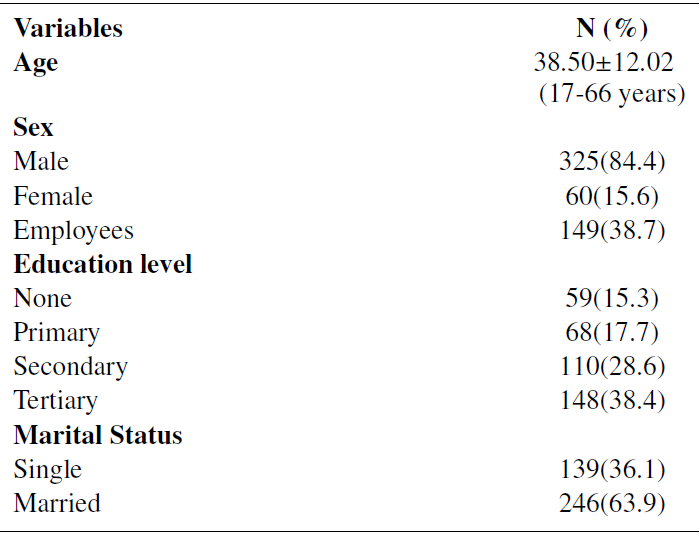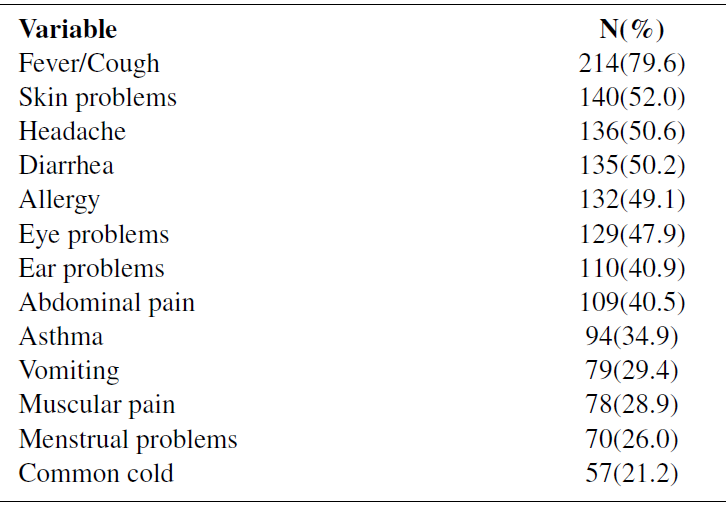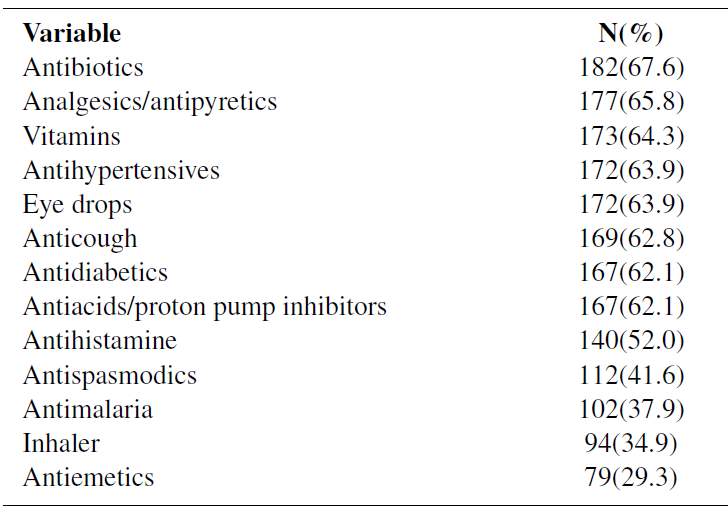Full HTML
Self-medication practice in Shabwah Governorate, Yemen: A cross-sectional survey
Hesham Saeed Hezam 1, Musaab Fahmi Yousef2
Author Affiliation
1Dept. of Intensive Care Unit, Maternal and Childhood Hospital, Shabwah, Governorate, Yemen
2Dept. of Medicine, University of Jordan, School of Medicine, Amman, Jordan
Abstract
Background: Self-medication is common in developing countries. In Yemen, there is little data on the prevalence of self-medication and possible factors influencing this practice. This study aimed to determine the prevalence of self-medication and to explore the attitude, knowledge, and practice of self-medication in Shabwah Governorate, Yemen.
Materials and Methods: This cross-sectional study was conducted in Shabwa Governorate, Yemen from January 1, 2024 to March 31, 2024. Approximately 385 households within the governorate areas were selected through systematic random sampling. Permission to conduct this study was obtained from local authorities as there is no research committee in the governorate.
Results: A total of 385 study participants were recruited with a response rate of 100% (N = 385). The prevalence of self-medication in this study was 69.9%. The most common reason for self-medication was time-saving 180 (66.9%), followed by cost-saving 137 (50.9%). The main indication for self-medication was fever/cough 214 (79.6%), followed by skin problems 140 (52.0%), while the most commonly used self-medication was antibiotics. Most 220 participants (81.8%) were unaware of the side effects before self-medication.
Conclusion: Self-medication has become a significant health and well-being problem in Shabwah Governorate, which has been exacerbated by the current situation in the country. In this study, the prevalence of self-medication was 69.9%. We recommend investigating self-medication practices across the country to generalize our findings and help health authorities formulate their policies on the rational use of medicines in the country and raise awareness among the population about the disadvantages of self-medication.
DOI: 10.18231/j.yjom.2024.009
Keywords: Self-medication, Diarrhea, Antibiotics, Prevalence, Fever, Shabwah, Yemen
Pages: 131-135
View: 3
Download: 6
DOI URL: http://doi.org/10.18231/j.yjom.2024.009
Publish Date: 11-09-2024
Full Text
Nowadays, medicines are easily available and some drugs are now even sold in supermarkets. In addition, in some countries, especially developing countries, people often go to the pharmacy to get advice or treatment for common ailments without consulting a physician. This type of practice among the population is called self-medication practice. The World Health Organization (WHO) has defined self-medication as “the use of drugs to treat selfidentified symptoms or use of prescribed drug continuously or intermittently for chronic or recurrent diseases without periodic consultation with health care provider. 1
Self-medication practice is a worldwide health problem with serious public health implications. Several studies conducted on self-medication practice revealed that it is a common practice, particularly in economically poor populations. 2 The intention of utilizing self-medication may be affected by various factors, such as individual, organizational, and environmental variables. Cost-saving, time-saving, advice from friends & relatives, mild illness, lack of confidence in the health workers, high doctor fees, and lack of appropriate health facilities were some of the reasons for self-medication practice. 2–4
In Yemen, the civil war resulting from the sociopolitical conflict has affected all aspects of life, including the health sector, which suffers from a lack of basic health care, poor facilities, and lack of access to essential medicines, in addition, medications are often dispensed by non-medical staff at medical stores without a prescription. Therefore, self-medication may offer an easier and more cost-effective opportunity to the population. However, there is a paucity of data on self-medication prevalence and possible factors that influence this practice. This study aimed to determine the prevalence of self-medication and to explore the attitude, knowledge, and practice of self-medication in Shabwah Governorate, Yemen.
Study design, and setting
This cross-sectional survey was conducted, from January 1, 2024, to March 31, 2024, in Shabwah Governorate, which is the third-largest governorate by area in Yemen and is located in the center of the country. This governorate, which is under the control of the internationally recognized government, consists of 17 districts covering an area of around 43,000 square kilometers and has the lowest population density in Yemen. Shabwah’s estimated population of between 600,000 and 950,000 is spread across several small urban centers – the largest being the capital Ataq – and numerous small towns, villages, and hamlets. 5
Inclusion and exclusion criteria
Inclusion criteria for the survey were residents who were at least 17 years old and who had resided in the Shabwah Governorate for not <6 months. The resident was to be one who had practiced self-medication, at least, over the past 3 months, and who had consented to be a part of the study. Incompletely filled questionnaires were not included in this survey.
Sample size and sampling technique
The sample size was calculated by adopting a 95% confidence level, and 5% margin of error at a response distribution of 50% for the population (n = 925,000) The estimated sample size was 385. Households within the areas of the governorate were selected by systematic random sampling.
Data collection instrument
An adapted questionnaire from a previous study, 6 modified slightly, was used as a data collection instrument. The questionnaire was tested for face validity by a panel of subject experts and modified in accordance with their recommendations to ensure comprehension by respondents. Verbal consent was taken from all subjects.
Data analysis and ethical approval
Data collected were coded, stored, and analyzed using the Statistical Package for the Social Sciences (SPSS) Version 21 Results were presented as means ±standard deviation (SD) for quantitative variables, while qualitative variables were described as numbers and percentages. The permission to conduct this study was obtained from the local authorities as there is no research committee in the governorate.
Demographic information about the participants
From January 1, 2024, to March 31, 2024, A total of 385 participants were selected to assess their selfmedication practice. All participants received and filled out the questionnaire and returned it to the investigators (Response rate 100%). Of all, 84.4% (n=325) were male and 15.6% (n=60) were female. The mean age of the participants was 38.50±12.02(range:17-66 years) and most of them had secondary and tertiary levels of education. Table 1 shows the detailed demographic information about the participants.
Table 1: Socio-demographics

Prevalence of self-medication practice, attitude toward it, and the reasons for its acceptance and avoidance
The prevalence of self-medication practice was 69.9% (n=269). Among participants accepting self-medication practice, the common reason was time-saving 180(66.9%), followed by cost-saving 137(50.9%), lack of confidence in the health workers 128(47.6%), and high doctor fees 127(47.2%). On the other hand, the participants who prefer to avoid self-medication justified their opinion by the following: 110(94.8%) wanted to avoid the risk of using the wrong medication, 99(85.3%) wanted to avoid the risk of wrong diagnosis, and 67(57.8%) wanted to avoid the risk of adverse drug reaction. Table 2, describes the attitude of the participants toward self-medication and the reasons for accepting or avoiding self-medication practice.
Table 2. Attitude of the participants to ward Self medication practice

Indications of self-medication practice and the purchased self-medications
The most common indication for self-medication was fever/cough accounting for 79.6% of cases (n=214), followed by skin problems 140(52.0%), headache 136(50.6), and diarrhea 135(50.2%). Table 3 describes the indications of self-medication. Antibiotics were the most commonly purchased drug, while analgesics/antipyretics ranked second. Table 4 summarizes the purchased selfmedications.
Table 3: Indications of self-medication in Shabwah Governorate

Table 4: Purchased self-medications Iin Shabwah Governorate

Side effects after self-medication and actions taken
Most participants 220 (81.8%) were unaware of the side effects before self-medication. The most common side effect reported was diarrhea 42(30.5), followed by allergic reactions 38(14.1). Stopping drugs was the most common action taken by 49.2% of the participants (n=29). Tables 5 and 6 describe side effects after self-medication and actions taken to counteract these effects.
Table 5: Side effects after self-medication

Table 6: Actions taken to counteract side effect of self-medication (n=59)

Irrational use of medicines among different populations is of great concern because most of them lack the knowledge or have little knowledge about the safety profile of the drugs that were self-medicated which finally might modulate severe adverse events in long-term use. A continuous worldwide increase in self-medication has been triggered by economic, political, and cultural factors and the practice is becoming a major public health problem. 7
Numerous studies were conducted in different countries that investigated self-medication practice among different groups of the population, which revealed that selfmedication practice is common and the prevalence varies throughout the world. Globally, the prevalence of selfmedication practice is varied from 11.9% to 91.4%. 8,9 The difference in the prevalence of self-medication practice among various studies may be due to the variation in the ease of accessibility to all medications (even those medicines that should only be dispensed with physicians’ prescriptions) from pharmacies and drug shops in different countries. Or it may be attributed to recall periods employed for self-medication practice, with some studies using 3 months and others using 6 months. Our study was the first in Shabwah Governorate, Yemen that showed self-medication practices are very common among the population in this governorate with a prevalence of 69.9%, which falls within the global range.
The reasons for preferring self-medication in our study were strongly related to the environmental characteristics of Shabwah Governorate, which has a huge area and lacks doctors in rural areas which are far from the main healthcare facilities. Thus, time-saving was the main reason for selfmedication among the participants in our study, which differs from other studies. For example, In Ghana. 10 the common reason for self-medication practice was Influence from others (Friends and family), in Nepal, 6 low cost was the main reason for self-medication, In Bangladesh, 11 lack of perceived seriousness of disease was the most common reason for self-medication, while in Nigeria and Pakistan, 12,13 minor illness was the common reason why participants engage in self-medication practice.
The common indication for self-mediation in our study was fever/cough 214 (79.6%), which coincides with results from India 8,14,15, the Philippines 16, and Bangladesh. 11 This finding contradicts other studies from other countries. For example In Nepal 6 , Gaza strip-Palestine 17, and Ethiopia 18 , headache was the common indication for self-medication, in Pakistan12, pain was the most common symptom for which self-medication was practiced. On the other hand, the type of utilized drugs would vary based on the nature of illness that indicates self-medication. Therefore, the current study showed that antibiotics were the class of drugs most self-medicated, which coincides with findings from a previous study from Yemen19, and other studies from Mexico20, Sudan21, and India. 22 One of the crucial aspects of self-medication is the side effects of the utilized drugs and awareness of the population of these side effects and how to deal with them. Several studies including ours, showed that most participants are unaware of the side effects before self-medication. 8–22 The common adverse reactions often associated with self-medication may include skin rashes, hypoglycemia, upper gastrointestinal bleeding, gastrointestinal upset, diarrhea, and hepatitis 8–21 The common side effect of self-medication in this study was diarrhea (Table 5).
Limitations of this study Recall bias could have happened due to the cross-sectional design and asking the participants to recall self-medication in the last 3 months. Moreover, selection bias could also happen due to involving participants who were willing to participate in the research, which may affect the characteristics of the participants leading to a bias in the results. Although we covered all governorate districts, conducting the study in one governorate does not allow us to generalize our results to the whole country.
Self-medication has become a significant health and wellbeing problem in Shabwah Governorate, which has been exacerbated by the current situation in the country. In this study, the prevalence of self-medication was 69.9%. The common reason for self-medication was time-saving, and the most common indication for self-medication was fever/cough. Whereas the most common self-medication used was antibiotics. Most participants were unaware of the side effects before self-medication. We recommend conducting research on self-medication practice throughout the country to generalize our results and to help health authorities formulate their policy on the rationale use of medications in the country and to increase population awareness of the disadvantages of self-medication.
Authors’ Contribution
All authors made a significant contribution to the work reported, whether that is in the conception, study design, execution, acquisition of data, data analysis, and interpretation, or all these areas. All authors took part in drafting, revising, or critically reviewing the article; and gave final approval of the version to be published.
Source of Funding
None.
Conflict of Interest
None.
References
1. Thomas D, Zachariah S. Knowledge, attitude, and practice of pharmacovigilance in developing countries. In: and others, editor Social and Administrative Aspects of Pharmacy in Low-and MiddleIncome Countries: Present Challenges and Future Solutions. Elsevier Inc; 2018. p. 177–93
2. Geissler PW, Nokes K, Prince RJ, Achieng’odhiambo R, Hansen JA, Ouma JH, et al. Children and medicines: self-treatment of common illnesses among Luo schoolchildren in western Kenya. Social Sci Med. 2000;50(12):1771–83.
3. Kassie AD, Bifftu BB, Mekonnen HS. Self-medication practice and associated factors among adult household members in Meket district. BMC Pharmacol Toxicol. 2017;19(1):15. doi:Abstract.
4. Shankar PR, Partha P, Shenoy N. Self-medication and nondoctor prescription practices in Pokhara valley, Western Nepal: a questionnaire-based study. BMC Fam Pract. 2002;3:1–7.
5. Hezam HS. Knowledge, attitudes, and practices toward COVID-19 among healthcare workers in Shabwah Governorate, Yemen: A crosssectional study. Yemen J Med. 2022;1(1):31–5.
6. Parajuli SB, Mishra A, Kc H, Bhattarai P, Karki S, Pandit R, et al. SelfMedication Practices in Surrounding Communities of Birat Medical College and Teaching Hospital of Eastern Nepal. JCMS Nepal. 2019;15:45–52.
7. Filho ADL, Lima-Costa MF, Uchoa E. Bambui project qualitative approach to self-medication. Cadernos de Saude Publica. 2004;20(6):1661–70.
8. Selvaraj K, Kumar SG, Ramalingam A. Prevalence of self-medication practices and its associated factors in Urban Puducherry, India. Perspect Clin Res. 2014;5(1):32–8.
9. Osemene A. A study of the prevalence of self-medication practice among university students in south western Nigeria. Trop J Pharm Res. 2012;11(4):683–9.
10. Mensah BN, Agyemang IB, Afriyie DK, Amponsah SK. Selfmedication practice in Akuse, a rural setting in Ghana. Niger Postgrad Med J. 2019;26(3):189–94.
11. Saha A, Zam D, Khan AA, Dutta P, Mannan A, Alam N. Prevalence and determinants of self-medication practices among general population: A cross-sectional study in Thimphu, Bhutan and Chattogram. J Public Health Res. 2023;12(1):22799036231152327.
12. Aqeel T, Shabbir A, Basharat H, Bukhari M, Mobin S, Shahid H, et al. Prevalence of self-medication among urban and rural population of Islamabad. Pak Trop J Pharm Res. 2014;13(4):627–60.
13. Anthony T, Olukayode A, Oyemomi A, Abidemi O, Ayodeji BO. Prevalence, practice, determinants and adverse effects of selfmedication among young people living in a suburban community of Ekiti, Nigeria: A community-based cross-sectional study. SAGE Open Med. 2024;12:20503121241261002.
14. Juneja K, Chauhan A, Shree T, Roy P, Bardhan M, Ahmad A, et al. Self-medication prevalence and associated factors among adult population in Northern India: A community-based cross-sectional study. SAGE Open Med. 2024;12:20503121241240507.
15. Rangari GM, Bhaisare RG, Korukonda V, Chaitanya YL, Hanumanth N. Prevalence of self-medication in rural area of Andhra Pradesh. J Family Med Prim Care. 2020;9(6):2891–9.
16. See L, Arce JR, Plaza A, Caño F. Attitude and Practices on Over-theCounter (OTC) Medicine use in Cebu City. Int J Pharm Teac Pract. 2015;6(3):2136–45.
17. Tarazi S, Almaaytah A, Laham A, Ayesh N, Arafat B. Prevalence of Self-Medication Practice Among Al-Azhar Medical Laboratory University Students Gaza Strip -Palestine. Indian J Res. 2016;5(10):231–4.
18. Mamo S, Ayele Y, Dechasa M. Self-Medication Practices among Community of Harar City and Its Surroundings, Eastern Ethiopia. J Pharm. 2018;25(1):2757108.
19. Alshakka M, Al-Abd N, Knowledge AS. Attitude and Practice of Self Medication: A Cross-sectional Study among Yemeni Health Profession Students. J Drug Deliv Therap. 2019;9(3):130–7.
20. Bojalil R, Calva JJ. Antibiotic misuse in diarrhea. A household survey in a Mexican community. J Clin Epidemiol. 1994;47(2):147–56.
21. Saeed AA, Isameldin E. Self-medication Practice among patients living in Soba-Sudan. Health Prim Car. 2020;4:1–5.
22. Chowdhury MH, Papi D. Prevalence and impact of OTC drug in the Aalo. Int J Pharm Sci Inve. 2022;11(4):13–9.
